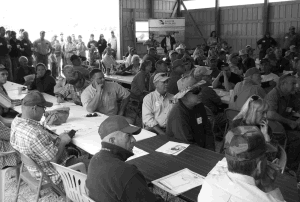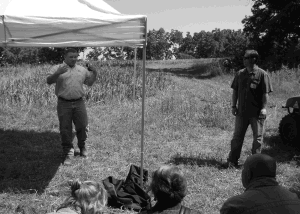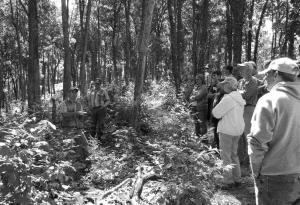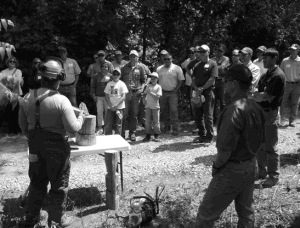Green Horizons
Volume 16, Number 3Summer 2012
Rick Merritt, Missouri Tree Farm Committee
Beautiful weather and a great program combined to draw a record crowd to this yearís annual conference, hosted by John and Stacy Heckman, north of Hermann. Over 180 landowners and natural resource professionals came together to see how John and his family have implemented various forest and wildlife management practices on their property to enhance both trees and critters that call their Bear Valley Tree Farm home.
 |
| Standing room only at this yearís Missouri Tree Farm Conference! |
After a few short welcoming formalities, everyone was eager to get into the field. First stop was a field being restored to warm season grasses and forbs. The casual observer might think itís just a field of weeds. But, to a landowner wanting to diversity his or hersí natural plant communities it was a field full of warm-season grasses like black-eyed Susan, Ox-eye daisy, and Ladiesí tresses. Retired MDC Private Lands Conservationist and president of the Missouri Grouse Chapter of Quail and Upland Wildlife Federation, Tom Westhoff, explained how the judicious use of prescribed fire and herbicides can be used to establish and maintain these oases for small upland game birds. This field was abuzz (literally) with loads of honeybees and from the far end one could hear bobwhite quail whistling to their heartís content.
 |
| A sea of warm-season grasses greeted conference attendees at the first stop. |
On up the ridge, the next stop was at a fieldís edge where John had converted a fescue field infested with honeylocust and cedar into an annual food plot for deer and turkey. The field is rotated between milo and winter wheat. It is occasionally left fallow. Missouri Department of Conservation, Jamie Barton, talked about the ease of planting these simple types of food plots and the benefits they provide. He covered the types of tools and implements used to install and maintain food plots and how to control invasive plant, such as honeylocust and cedar.
 |
 |
| MDC Private Land Conservationist, Jamie Barton (left) told the crowd how to convert abandoned fields into productive wildlife food plots. | Josh Stevens told interested landowners how to improve their woodlands for both timber and wildlife. |
Up in the timber, conference attendees learned that that could have their cake and eat it, too! By removing slowgrowing, poorly-formed trees and undesirable tree species from the forest (think of it as weeding your woodland garden) the remaining trees have more room to grow. And more room to grow means bigger tree crowns resulting in more acorns and hickory nuts for wildlife.
 |
| Tree Farm Day participants got plenty of exercise. Fortunately, Mother Nature provided cool temperatures and a gentle breeze, so it was a comfortable trek back to the barn for lunch. |
After lunch individuals could take themselves on a selfguided tree identification trail or learn the finer points of pruning high-value trees like walnut and white oak. The afternoon concluded with professional timber harvester, Joe Glenn, talking about chain saw safety and demonstrating proper tree felling techniques. Those in attendance quickly realized that a one-hour demonstration is not sufficient training to start cutting down trees of size on their own. Fortunately, Joe offers comprehensive training through the Missouri Forest Products Professional Timber Harvesters program. To learn more and to register for the next course, contact the MFPA office (573) 634-3252 or online at www.moforest.org.
The Heckmans are excited about the many benefits of their hard work. They anticipate having a timber sale in the near future to generate revenue and have seen increased numbers of quail turkey and other wildlife that make their farm a more enjoyable place. John and his family are not only dedicated to their farm, but would like to see others connect with the resources they need to reach forest and wildlife habitat management goals for their properties. To locate your closest professional forester, contact either the Missouri Department of Conservation (573-751-4115 or www.mdc.mo.gov) or the Missouri Consulting Foresters Association (www.missouriforesters.com).
 |
 |
| After talking the crowd through the process of safely felling a tree, professional timber harvester, Joe Glenn, drops a rather difficult elm exactly where he said he would! | |